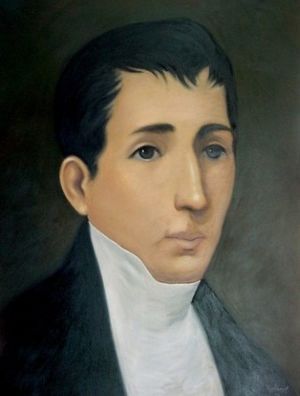Norberto Ramírez facts for kids
Quick facts for kids
Norberto Ramírez
|
|
|---|---|
 |
|
| Supreme Chief of El Salvador | |
| In office 20 September 1840 – 7 January 1841 |
|
| Preceded by | Antonio José Cañas |
| Succeeded by | Juan Lindo |
| Supreme Director of Nicaragua | |
| In office 1 April 1849 – 1 April 1851 |
|
| Preceded by | Benito Rosales |
| Succeeded by | Justo Abaunza |
| Personal details | |
| Born | 15 April 1802 León, Captaincy General of Guatemala |
| Died | 11 July 1856 (aged 54) León, State of Nicaragua |
| Nationality | Nicaraguan |
| Political party | Legitimist |
Norberto Ramírez Áreas was an important Nicaraguan lawyer and politician. He was born in León, Nicaragua on April 15, 1802, and passed away in the same city on July 11, 1856.
Ramírez held leadership roles in two Central American countries. He served as the acting Supreme Chief of El Salvador from September 20, 1840, to January 7, 1841. At that time, El Salvador was still part of the Federal Republic of Central America. Later, he became the 6th Supreme Director of independent Nicaragua from April 1, 1849, to April 1, 1851.
Contents
Early Life and Family
Norberto Ramírez was born in León on April 15, 1802. He studied law at the local university there.
His daughter, Mercedes Ramírez de Meléndez, had two sons. These grandsons, Carlos Meléndez and Jorge Meléndez, later became presidents of El Salvador themselves.
Leadership in El Salvador
On September 20, 1840, a group of soldiers in San Salvador rebelled. This revolt was led by General Francisco Malespín. It forced the previous leader, Colonel Antonio José Cañas, to step down.
After another person declined the job, Norberto Ramírez took over the government. He became the Supreme Chief of El Salvador.
In December 1840, a small uprising happened in Santiago Nonualco. It was led by Petronilo Castro. However, the government quickly stopped this riot. Even though Ramírez was in charge for only a few months, he managed the difficult political situation well.
A special meeting, called the Constituent Assembly, took place on January 4, 1841. On January 7, they accepted Colonel Cañas's official resignation. They then chose Juan Lindo to be the new provisional head of the state. Ramírez handed over his power to Lindo on the same day. He then became a deputy chief, working alongside Pedro José Arce and Joaquín Eufrasio Guzmán.
Leadership in Nicaragua
On March 5, 1849, the Legislative Assembly of Nicaragua officially declared Norberto Ramírez as the elected Supreme Director. He began his term on April 1.
As Supreme Director, Ramírez ordered the army commander, Fruto Chamorro, to stop ongoing rebellions. These revolts were led by a general named Bernabé Somoza. Somoza was eventually captured and executed in Rivas.
Important Treaties
On July 9, 1849, Ramírez met with Ephraim George Squier. Squier was a historian and the special representative from the United States to Central America. He arrived in Nicaragua on September 5. Squier brought a message from the United States. It showed their support for Nicaragua against British claims in the region.
Later in 1849, Ramírez sent a lawyer named Eduardo Carcache to Washington. Carcache was Nicaragua's first special representative to the United States. His job was to try and get a treaty signed about building a canal across Nicaragua. He also aimed to get U.S. support in a disagreement with England. This disagreement was about who controlled the San Juan River and the Mosquito Coast.
The Clayton–Bulwer Treaty was signed in 1850 between the United States and the United Kingdom. This treaty meant that neither country would claim full control or special rights over the planned Nicaraguan canal. On July 25 of the same year, Nicaragua also signed a Treaty of Peace and Friendship with Spain. This treaty officially recognized Nicaragua's independence.
See also
 In Spanish: Norberto Ramírez para niños
In Spanish: Norberto Ramírez para niños

